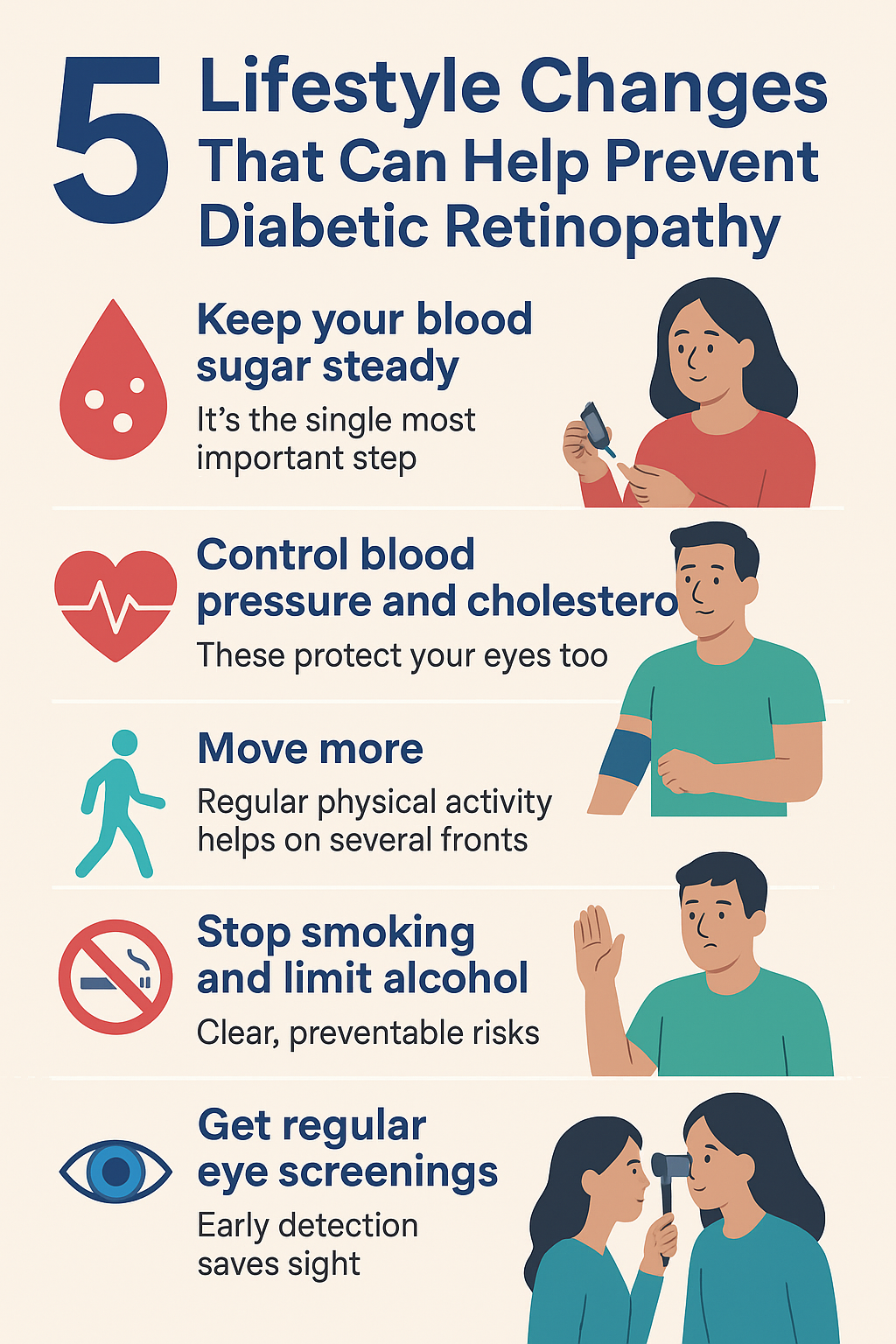Living with diabetes can feel like a long list of “must-dos.” But when it comes to protecting your eyes, small everyday choices add up. Diabetic retinopathy causes damage to the small blood vessels at the back of the eye and it is one of the leading causes of vision loss in people with diabetes. The good news: by managing your overall health and adopting a few practical habits, you can significantly lower your risk and protect your sight. Below are five evidence-backed, easy-to-follow lifestyle changes, explained in plain language and with real tips you can start using today.
1. Keep your blood sugar steady — it’s the single most important step
High and fluctuating blood sugar levels damage tiny retinal blood vessels over time. Tight, consistent blood glucose control slows the progression of diabetic retinopathy and reduces the risk of sight-threatening complications. That doesn’t mean never having a sugary treat but it means steady habits, monitoring, and working with your doctor to set realistic targets.
Practical tips
-
Check blood sugar as recommended and keep a simple log and seeing trends helps you and your doctor adjust treatment.
-
If you take insulin or diabetes medicines, learn how meals and activity affect your readings.
-
Aim for gradual, sustainable changes in diet and activity rather than extreme short-term fixes.
2. Control blood pressure and cholesterol — these protect your eyes too
High blood pressure and abnormal cholesterol levels increase the stress on retinal vessels and speed up eye damage. Studies and clinical guidelines highlight that managing blood pressure and lipids alongside blood sugar reduces the chance of vision-threatening retinopathy.
Practical tips
-
Get your blood pressure checked regularly; small reductions in BP lower eye risk.
-
If prescribed, take blood-pressure and cholesterol medications consistently but don’t skip because you “feel fine.”
-
Choose whole foods (vegetables, pulses, whole grains) and reduce fried/processed foods to help both BP and cholesterol.
3. Move more – regular and consistent physical activity helps on several fronts
Exercise improves insulin sensitivity, helps control weight, lowers blood pressure, and supports overall vascular health all of which reduce stress on the retina. The exact “best” exercise varies by person, but consistency matters more than intensity. Even walking 30 minutes most days can make a meaningful difference.
Practical tips
-
Start with a daily 20–30 minute walk. Break it into two 10–15 minute walks if that’s easier.
-
Mix gentle strength training twice a week (bodyweight squats, light dumbbells) to improve metabolic health.
-
If you have complications (e.g., neuropathy, heart disease), check with your doctor before starting a program.
4. Stop smoking and limit alcohol absolute and clear, preventable risks
Smoking is consistently linked with worse outcomes in diabetic eye disease; quitting is one of the most powerful changes you can make to protect your circulation including in your eyes. Heavy alcohol intake can worsen blood sugar control and interact with medications; moderation is important.
Practical tips
-
Ask your healthcare team about local quit programs, nicotine replacement, or medicines that can help — you don’t have to quit alone.
-
Replace smoking breaks with short walks or deep-breathing exercises.
-
If you drink, follow medical guidance: keep it moderate and avoid binge drinking.
5. Get regular eye screenings as early detection saves eyesight
Lifestyle changes are powerful, but early detection through eye exams is equally critical. In the early stages diabetic retinopathy often has no symptoms, so waiting for vision problems is a risky strategy. Regular dilated eye exams and imaging (like fundus photos or OCT scans) detect changes early when treatments are most effective. Screening frequency depends on type and duration of diabetes, but at minimum, people with diabetes should have an annual retinal check or as advised by their eye specialist.
Practical tips
-
Book an annual dilated eye exam . Write it in your calendar like any other important appointment.
-
If your specialist recommends more frequent checks (for example, if you have early retinopathy), follow their schedule.
-
Keep records of your eye images/reports so future doctors can compare and spot changes quickly.
A gentle, practical hope
Living with diabetes can feel overwhelming. But the actions that protect your eyes are largely the same things that protect your heart, kidneys, and overall wellbeing. The benefit is cumulative and every steady meal, every walk, every check-up makes your future brighter. If you’re in Vadodara and want a trusted place for screening or treatment, Vala Eye Centre offers diabetic eye exams, OCT imaging, and individualized care plans. Early checks and small lifestyle steps together give you the best chance of keeping your vision. If you’d like, we can draft a short patient-facing checklist or an appointment-ready page for the clinic.

